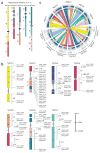The genome of the extremophile crucifer Thellungiella parvula
- PMID: 21822265
- PMCID: PMC3586812
- DOI: 10.1038/ng.889
The genome of the extremophile crucifer Thellungiella parvula
Abstract
Thellungiella parvula is related to Arabidopsis thaliana and is endemic to saline, resource-poor habitats, making it a model for the evolution of plant adaptation to extreme environments. Here we present the draft genome for this extremophile species. Exclusively by next generation sequencing, we obtained the de novo assembled genome in 1,496 gap-free contigs, closely approximating the estimated genome size of 140 Mb. We anchored these contigs to seven pseudo chromosomes without the use of maps. We show that short reads can be assembled to a near-complete chromosome level for a eukaryotic species lacking prior genetic information. The sequence identifies a number of tandem duplications that, by the nature of the duplicated genes, suggest a possible basis for T. parvula's extremophile lifestyle. Our results provide essential background for developing genomically influenced testable hypotheses for the evolution of environmental stress tolerance.
Conflict of interest statement
The authors declare no competing financial interests.
Figures




Similar articles
-
Genome structures and halophyte-specific gene expression of the extremophile Thellungiella parvula in comparison with Thellungiella salsuginea (Thellungiella halophila) and Arabidopsis.Plant Physiol. 2010 Nov;154(3):1040-52. doi: 10.1104/pp.110.163923. Epub 2010 Sep 10. Plant Physiol. 2010. PMID: 20833729 Free PMC article.
-
Genomes of extremophile crucifers: new platforms for comparative genomics and beyond.Genome Biol. 2012 Aug 16;13(8):166. doi: 10.1186/gb-2012-13-8-166. Genome Biol. 2012. PMID: 22897896 Free PMC article.
-
The Whole Genome Assembly and Comparative Genomic Research of Thellungiella parvula (Extremophile Crucifer) Mitochondrion.Int J Genomics. 2016;2016:5283628. doi: 10.1155/2016/5283628. Epub 2016 Apr 11. Int J Genomics. 2016. PMID: 27148547 Free PMC article.
-
Chromosome evolution.Curr Opin Plant Biol. 2007 Apr;10(2):109-15. doi: 10.1016/j.pbi.2007.01.001. Epub 2007 Feb 7. Curr Opin Plant Biol. 2007. PMID: 17289425 Review.
-
Learning from evolution: Thellungiella generates new knowledge on essential and critical components of abiotic stress tolerance in plants.Mol Plant. 2009 Jan;2(1):3-12. doi: 10.1093/mp/ssn094. Mol Plant. 2009. PMID: 19529830 Free PMC article. Review.
Cited by
-
Comparison of freezing tolerance, compatible solutes and polyamines in geographically diverse collections of Thellungiella sp. and Arabidopsis thaliana accessions.BMC Plant Biol. 2012 Aug 3;12:131. doi: 10.1186/1471-2229-12-131. BMC Plant Biol. 2012. PMID: 22863402 Free PMC article.
-
dbWFA: a web-based database for functional annotation of Triticum aestivum transcripts.Database (Oxford). 2013 May 9;2013:bat014. doi: 10.1093/database/bat014. Print 2013. Database (Oxford). 2013. PMID: 23660284 Free PMC article.
-
Life at the extreme: lessons from the genome.Genome Biol. 2012;13(3):241. doi: 10.1186/gb-2012-13-3-241. Genome Biol. 2012. PMID: 22390828 Free PMC article. Review.
-
Fibrillarin evolution through the Tree of Life: Comparative genomics and microsynteny network analyses provide new insights into the evolutionary history of Fibrillarin.PLoS Comput Biol. 2020 Oct 19;16(10):e1008318. doi: 10.1371/journal.pcbi.1008318. eCollection 2020 Oct. PLoS Comput Biol. 2020. PMID: 33075080 Free PMC article.
-
Thirteen Dipterocarpoideae genomes provide insights into their evolution and borneol biosynthesis.Plant Commun. 2022 Nov 14;3(6):100464. doi: 10.1016/j.xplc.2022.100464. Epub 2022 Oct 27. Plant Commun. 2022. PMID: 36303430 Free PMC article.
References
-
- Al-Shehbaz IA, O’Kane SL. Placement of Arabidopsis parvula in Thellungiella (Brassicaceae) Novon. 1995;5:309–310.
Publication types
MeSH terms
Grants and funding
LinkOut - more resources
Full Text Sources
Molecular Biology Databases
Miscellaneous

